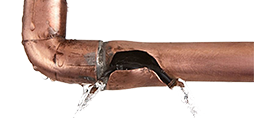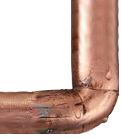Leaks from pipes, plumbing fixtures and fittings are a substantial source of water waste for many homes. If not caught and repaired, these leaks can cause significant damage. Kentwood Water Restoration specializes in water leak repairs and can advise homeowners on a variety of leak repair options for some of those most frequent occurrences.
Slab Leaks
A slab leak happens when the pipes in the water lines beneath your home break or burst. The leak is not actually in the slab, but in the pipes under the concrete slab of your home. Signs of trouble include:
-
The sound of running water when all water is turned off
-
A warm spot on the floor
-
Cracks in your walls or flooring
-
Mildew or moisture under carpets or flooring
-
Higher-than-average water bills
Leak Repair Options
-
Re-piping – This solution is often used if there are multiple leaks and will probably require invasive cutting into your floors and concrete slab in order to access the pipe leak and install brand new piping.
-
Pipe re-routing – With this repair, new pipe is run above ground. This option is ideal if only a short length of pipe needs to be replaced.
-
Pipe Relining – Depending on the size of the leak, a new liner can be pushed through a broken sewer pipe to cover breaks and seal all leaks. This is trenchless pipe repair technology and only requires access holes on either end of the pipe, as opposed to digging a trench to uncover the entire length of buried pipe. An epoxy infused flexible sleeve is pulled through the old pipe which cures in place to become strong, rigid pipe as smooth as new PVC pipe.
Shower and Tub Leaks
If you see water stains on the ceiling below, or if you notice loose flooring near the tub, you may have a drain leak.
Leak Repair Options
-
For a tub drain, unscrew the drain flange from above, clean the flange and apply silicone caulk. Remove the rubber gasket under the drain hole and replace it with a new gasket.
Toilet Leaks
Toilets are one the most common types of leaks and they usually go undetected. The most harmful leaks happen at the flange and the wax ring. Signs that you have a leaky toilet include:
-
Water leaking around the base
-
Loose or damaged flooring
-
Stains on the ceiling below
-
A toilet that rocks slightly when you push against it
Leak Repair Options
If you have a stain near the toilet, a leaking flange is the likely source. Remove the toilet to locate the leak.
-
For a cracked flange or broken bolt slots, install a metal repair flange
-
If the flange is loose, tighten it to the subfloor
-
If the flange is too low, install a hard plastic flange riser over the existing flange
If the problem is not a leaky flange, you may need to reinstall the toilet with a new wax ring.
Sink Leaks
For kitchen and bathroom sinks, signs of trouble include water stains or an odor inside the cabinet, as well as loose or damaged flooring in front of the sink.
Leak Repair Options
-
For a slip joint leak, tighten the slip nut. If that doesn’t work, take apart the joint, coat the washer with Teflon joint compound and reassemble.
-
For a leak from the basket strainer, tighten the ring nut under the sink. If the leak continues, disconnect and remove the basket strainer and reassemble it.
If you suspect a leak in your home, call your local Kentwood Water Restoration plumber for an inspection. If you experience flooding due to a leak, we provide full-service plumbing repair, including water damage restoration.


